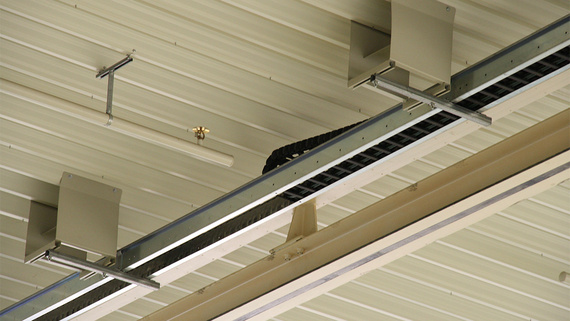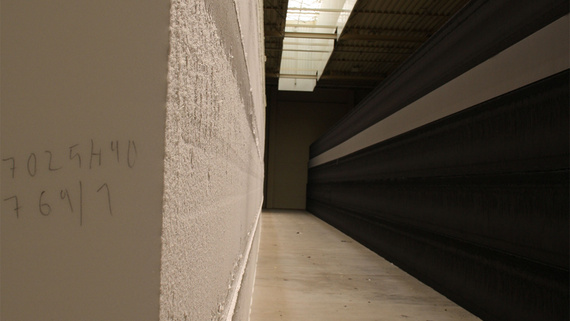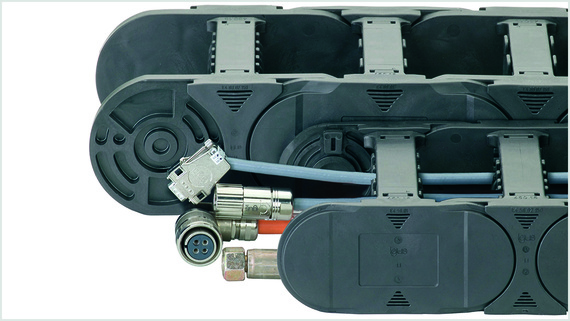Marathon energy chains in indoor cranes
E4 energy chains in continuous operation for 15 years at foam specialist Carpenter
Carpenter provides comfort with foam for mattresses, furniture, insulation and packaging. The original material is manufactured in the Thuringian factory of the American upholstery and foam specialist in impressive dimensions: flexible polyurethane foam blocks 60 meters in length, two meters in height and width and, depending on the material, with a weight of three to eight tons. Handling is carried out by several fully automatic, remote-controlled process cranes equipped with our energy chains.Profile
- What was needed: Energy chains of the E4 series, including zig-zag design, the i.Cee system for predictive maintenance of energy chains.
- Requirements: With a high load in continuous operation (150 storage and retrieval processes/day; 210,000 travel movements/year), an extremely fail-safe system for signal and energy supply had to be found.
- Industry: Cranes, upholstery and foams
- Success for the customer: The robust E4 energy chains including intelligent predictive maintenance, guarantee maximum availability and recommend maintenance work even before unplanned downtimes can occur. The result: Already 15 years of continuous operation (as of 2011)

Problem
Carpenter, a manufacturer of comfort upholstery products in Virginia, manufactures approximately 15,000 tons of foam and foam products every year. It opened in 1996 and currently has 36,000 square feet of space at its Ichtershausen facility near Erfurt, Germany. The foam blocks are used to produce goods on rolls, multi-dimensional contour cuts or profile sheets to customer specifications. True to the motto "We bring comfort to your life", Carpenter products provide more comfort in many areas of daily life, from comfortable seating on sofas, restful sleep on anatomically correct mattresses, a pleasant room climate thanks to high-tech insulation material or the safe packaging of a new television set on its way to the customer.The upholstery specialist uses four indoor cranes in its 15,000 square metre warehouse. The cranes are responsible for transporting the blocks away after production and storing them temporarily for complete drying. As the material is soft after the foaming process, it cannot be processed immediately. As soon as the foam is completely dry, the blocks are transported from the warehouse for further processing by an indoor crane with a travel speed of up to 60m/min. Each crane has two monorail trolleys that carry a 30-metre-long gripper to pick up the plastic blocks.
Each crane has to cope with around 150 storage and retrieval processes per day. With four cranes, this adds up to 210,000 travel movements per year. It is therefore essential that the cranes are operational at all times and are never down for more than 24 hours. If new blocks cannot be stored and stored blocks cannot be transported for further processing, production comes to a standstill. Since the entire logistics system operates on a just-in-time basis, the manufacturer cannot afford any downtime.
Solution
In order to keep plant availability close to 100 percent, Carpenter relied on the most reliable and low-maintenance components possible when designing the cranes, including our energy chain systems. The fact that the original chains and cables are still in use after 15 years proves that the system is right.Today, the hoist is connected to the gripper via an energy chain of type E4 in zig-zag arrangement, which is about six metres long. Approximately 90m long E4 energy chains, which run parallel to the crane rail in a horizontal galvanised sheet steel guide trough, are used as power supply lines for the trolley travel.
The travel is 80 metres, the lifting distance 5 metres. Experience showed that the chain system is exactly the right size for the application. It is true that individual cables and chain links have already had to be replaced, but not due to damage. It is because Carpenter has implemented a "predictive maintenance" system to avoid failures at all costs. The importance of a functioning crane system is immense. Despite the great success of the project, Carpenter was persuaded to test the successor model to the E4/0, the E4.1, which has been on the market since 2007, on one of the cranes. The advantages of the developed energy chain speak for themselves: The side parts of the E4.1 are connected to each other by a patented tongue and groove connection. This increases stability in both the pulling and pushing directions, for example when high lateral acceleration forces act on the chain. Overall, the E4.1 series are therefore more stable than their predecessors with the same or smaller dimensions. Almost all accessories and mounting dimensions are identical.
Martin Winter, CEO of Carpenter

